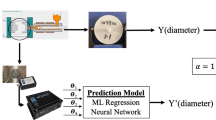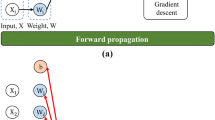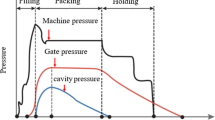Abstract
Injection molding is widely used for mass production of thermoplastic parts with complex geometry and tight dimensional tolerance. However, due to the unavoidable shrinkage and uncontrollable process condition variations, defective parts may occur. Thus, dimensional control and online defect detection are extremely important for quality control, particularly for high precision injection molding. The conventional monitoring and control are based on machine setting parameters, but it may not capture the molding condition variations under the unchanged machine settings. This paper develops an artificial neural network (ANN)-based online defect detection system with the real-time data extracted from in-mold temperature and pressure sensors. Both multilinear linear regression (MLR) and ANN models were developed based on the real-time data, but the ANN model is much better than the MLR model. The ANN model has a high prediction accuracy of 98.34% with the coefficient of determination R2 of 91.37%. When applied to defect detection, the ANN model has a defect detection accuracy of 94.4% in consideration of type I and type II errors. This research demonstrates the feasibility of integrating such an ANN-based expert system to injection molding process, to improve online dimensional monitoring. The ANN model also can be easily adapted for detecting other quality characteristics of injection moldings, which would be helpful for the advances in intelligent injection molding.









Similar content being viewed by others
References
Meza O, Vega E, Pérez E (2013) Influential factors on the outer lens color in an industrial injection molding process. Int J Adv Manuf Technol 66(1–4):455–460
Gong G, Chen JC, Guo G (2017) Enhancing tensile strength of injection molded fiber reinforced composites using the Taguchi-based six sigma approach. Int J Adv Manuf Technol 91(9–12):3385–3393
Guo G, Chen JC, Gong G (2018) Injection molding of polypropylene hybrid composites reinforced with carbon fiber and wood fiber. Polym Compos 39(9):3329–3335
Guo G, Finkenstadt VL, Nimmagadda Y (2019) Mechanical properties and water absorption behavior of injection-molded wood fiber/carbon fiber high-density polyethylene hybrid composites. Adva Composit Hybrid Mater 2(4):690–700
Guo G, Kethineni C (2020) Direct injection molding of hybrid polypropylene/wood-fiber composites reinforced with glass fiber and carbon fiber. Int J Adv Manuf Technol 106(1–2):201–209
Kramschuster A, Cavitt R, Ermer D, Chen Z, Turng LS (2005) Quantitative study of shrinkage and warpage behavior for microcellular and conventional injection molding. Polym Eng Sci 45(10):1408–1418
Shen C, Kramschuster A, Ermer D, Turng LS (2006) Study of shrinkage and warpage in microcellular co-injection molding. Int Polym Process 21(4):393–401
Kwon K, Isayev AI, Kim KH (2005) Toward a viscoelastic modeling of anisotropic shrinkage in injection molding of amorphous polymers. J Appl Polym Sci 98(5):2300–2313
Kurt M, Kaynak Y, Kamber OS, Mutlu B, Bakir B, Koklu U (2010) Influence of molding conditions on the shrinkage and roundness of injection molded parts. Int J Adv Manuf Technol 46(5–8):571–578
Santis FD, Pantani R, Speranza V, Titomanlio G (2010) Analysis of shrinkage development of a semicrystalline polymer during injection molding. Ind Eng Chem Res 49(5):2469–2476
Chen SC, Lin YC, Huang SW (2010) Study on the packing effects of external gas-assisted injection molding on part shrinkage in comparison with conventional injection molding. Polym Eng Sci 50(11):2085–2092
Jong WR, Hwang SS, Tsai MC, Wu CC, Kao CH, Huang YM (2017) Effect of gas counter pressure on shrinkage and residual stress for injection molding process. J Polym Eng 37(5):505–520
Qi GQ, Xu YJ, Yang W, Xie BH, Yang MB (2011) Injection molding shrinkage and mechanical properties of polypropylene blends. J Macromol Sci B 50(9):1747–1760
Lucyshyn T, Knapp G, Kipperer M, Holzer C (2012) Determination of the transition temperature at different cooling rates and its influence on prediction of shrinkage and warpage in injection molding simulation. J Appl Polym Sci 123(2):1162–1168
Wang R, Zeng J, Feng X, Xia Y (2013) Evaluation of effect of plastic injection molding process parameters on shrinkage based on neural network simulation. J Macromol Sci B 52(1):206–221
Abdul R, Guo G, Chen JC, Yoo JJW (2020) Shrinkage prediction of injection molded high density polyethylene parts with taguchi/artificial neural network hybrid experimental design. Int J Interact Des Manuf 14(2):345–357
Syed SF, Chen JC, Guo G (2020) Optimization of tensile strength and shrinkage of talc-filled polypropylene as a packaging material in injection molding. J Packag Technol Res 4(1):69–78
Guo G, Li Y, Zhao X, Rizvi, R (2020) Tensile and longitudinal shrinkage behaviors of polylactide/wood-fiber composites via direct injection molding. Polym Compos 1–15. https://doi.org/10.1002/pc.25741
Kc B, Faruk O, Agnelli JAM, Leao AL, Tjong J, Sain M (2016) Sisal-glass fiber hybrid biocomposite: optimization of injection molding parameters using Taguchi method for reducing shrinkage. Compos A: Appl Sci Manuf 83:152–159
Mohan M, Ansari MNM, Shanks RA (2017) Review on the effects of process parameters on strength, shrinkage, and warpage of injection molding plastic component. Polym-Plast Technol Eng 56(1):1–12
Mirjavadi SS, Forsat M, Barati MR, Hamouda AMS (2020) Investigating nonlinear vibrations of multi-scale truncated conical shell segments with carbon nanotube/fiberglass reinforcement using a higher order conical shell theory. J Strain Anal Eng Des. https://doi.org/10.1177/0309324720939811
Mirjavadi SS, Mohasel Afshari B, Shafiei N, Rabby S, Kazemi M (2018) Effect of temperature and porosity on the vibration behavior of two-dimensional functionally graded micro-scale Timoshenko beam. J Vib Control 24(18):4211–4225
Mirjavadi SS, Rabby S, Shafiei N, Afshari BM, Kazemi M (2017) On size-dependent free vibration and thermal buckling of axially functionally graded nanobeams in thermal environment. Appl Phys A 123(5):315
Shafiei N, Mirjavadi SS, Afshari BM, Rabby S, Hamouda AMS (2017) Nonlinear thermal buckling of axially functionally graded micro and nanobeams. Compos Struct 168:428–439
Woll SL, Cooper DJ, Souder BV (1996) Online pattern-based part quality monitoring of the injection molding process. Polym Eng Sci 36(11):1477–1488
Chen J, Savage M, Zhu JJ (2008) Development of artificial neural network-based in-process mixed-material-caused flash monitoring (ANN-IPMFM) system in injection molding. Int J Adv Manuf Technol 36(1–2):43–52
Yang Y, Gao F (2006) Injection molding product weight: online prediction and control based on a nonlinear principal component regression model. Polym Eng Sci 46(4):540–548
Michaeli W, Schreiber A (2009) Online control of the injection molding process based on process variables. Adv Polym Technol 28(2):65–76
Zhao P, Zhou H, He Y, Cai K, Fu J (2014) A nondestructive online method for monitoring the injection molding process by collecting and analyzing machine running data. Int J Adv Manuf Technol 72(5–8):765–777
Chen Z, Turng LS, Wang KK (2006) Adaptive online quality control for injection-molding by monitoring and controlling mold separation. Polym Eng Sci 46(5):569–580
Yang Y, Yang B, Zhu S, Chen X (2015) Online quality optimization of the injection molding process via digital image processing and model-free optimization. J Mater Process Technol 226:85–98
Fung KT, Gao F, Chen X (2007) Application of a capacitive transducer for online part weight prediction and fault detection in injection molding. Polym Eng Sci 47(4):347–353
Johnston SP, Kazmer DO, Gao RX (2009) Online simulation-based process control for injection molding. Polym Eng Sci 49(12):2482–2491
Kazmer DO, Johnston SP, Gao RX, Fan Z (2011) Feasibility analysis of an in-mold multivariate sensor. Int Polym Process 26(1):63–72
Gordon G, Kazmer DO, Tang X, Fan Z, Gao RX (2015) Quality control using a multivariate injection molding sensor. Int J Adv Manuf Technol 78(9–12):1381–1391
RJG eDART Process Control Software v10 Manual. https://rjginc.com/product/edart-software-v10/. Accessed 6 July 2020
Guyon I, Elisseeff A (2003) An introduction to variable and feature selection. J Mach Learn Res 3(Mar):1157–1182
Aghajani M, Keramati A, Moghadam RT, Mirjavadi SS (2016) A mathematical programming model for cellular manufacturing system controlled by kanban with rework consideration. Int J Adv Manuf Technol 83(5–8):1377–1394
Lei J (2019) Cross-validation with confidence. J Am Stat Assoc 1–20
Rojas R (1996) The backpropagation algorithm. In: Neural networks (pp. 149–182). Springer, Berlin, Heidelberg. https://link.springer.com/chapter/10.1007/978-3-642-61068-4_7
Acknowledgments
The authors are grateful to Winzeler Gear for providing the eDART system and supplying the Delrin 511DP acetal resin used in this study.
Funding
The authors are also grateful to the financial support from the Illinois Manufacturing Excellence Center (IMEC).
Author information
Authors and Affiliations
Corresponding author
Ethics declarations
Conflict of interest
The authors declare that they have no conflict of interest.
Additional information
Publisher’s note
Springer Nature remains neutral with regard to jurisdictional claims in published maps and institutional affiliations.
Rights and permissions
About this article
Cite this article
Chen, J.C., Guo, G. & Wang, WN. Artificial neural network-based online defect detection system with in-mold temperature and pressure sensors for high precision injection molding. Int J Adv Manuf Technol 110, 2023–2033 (2020). https://doi.org/10.1007/s00170-020-06011-4
Received:
Accepted:
Published:
Issue Date:
DOI: https://doi.org/10.1007/s00170-020-06011-4




